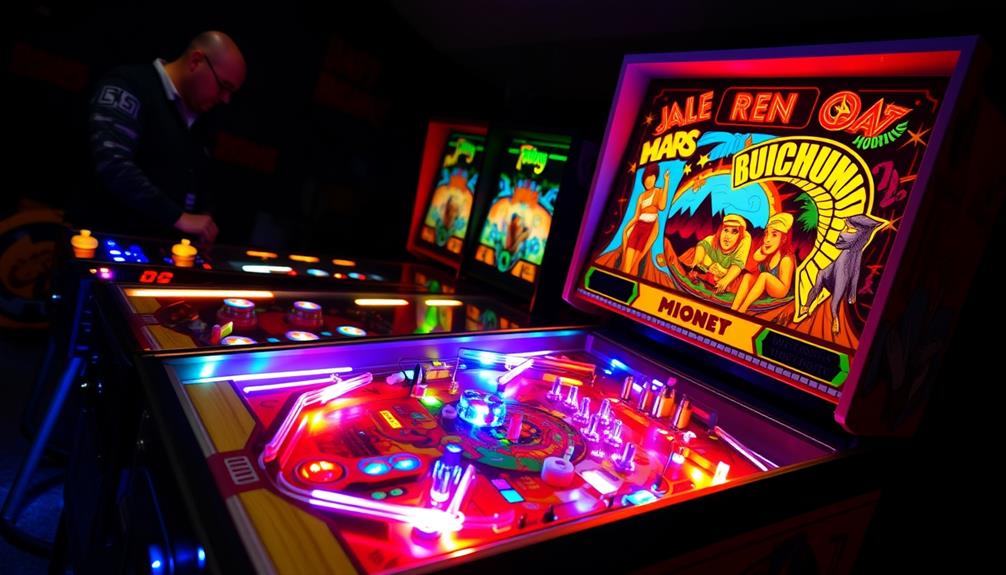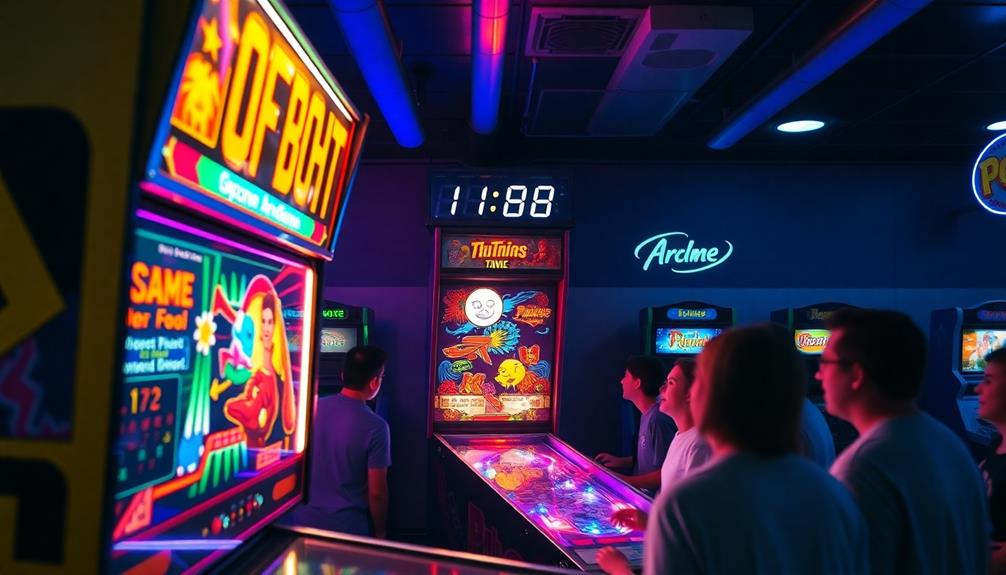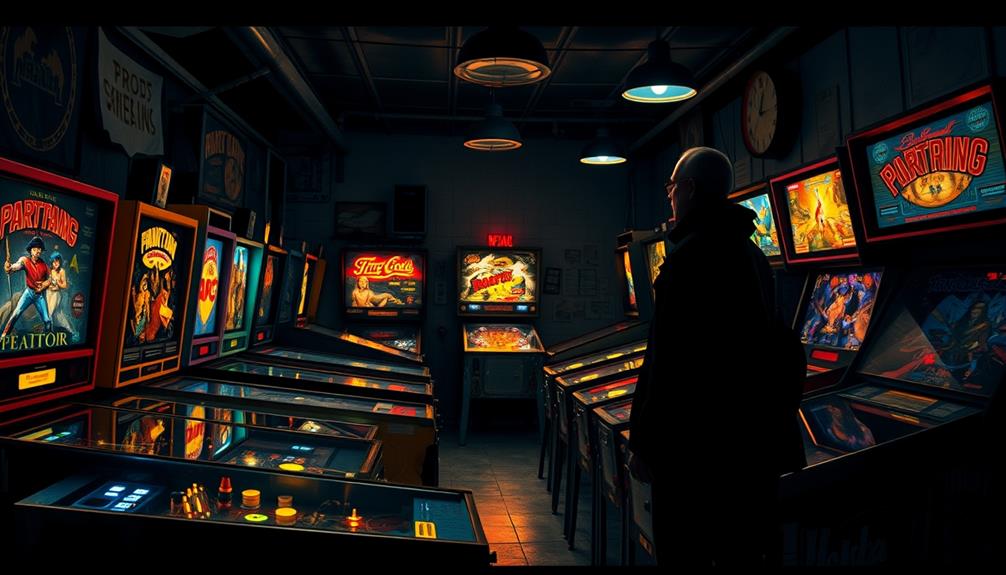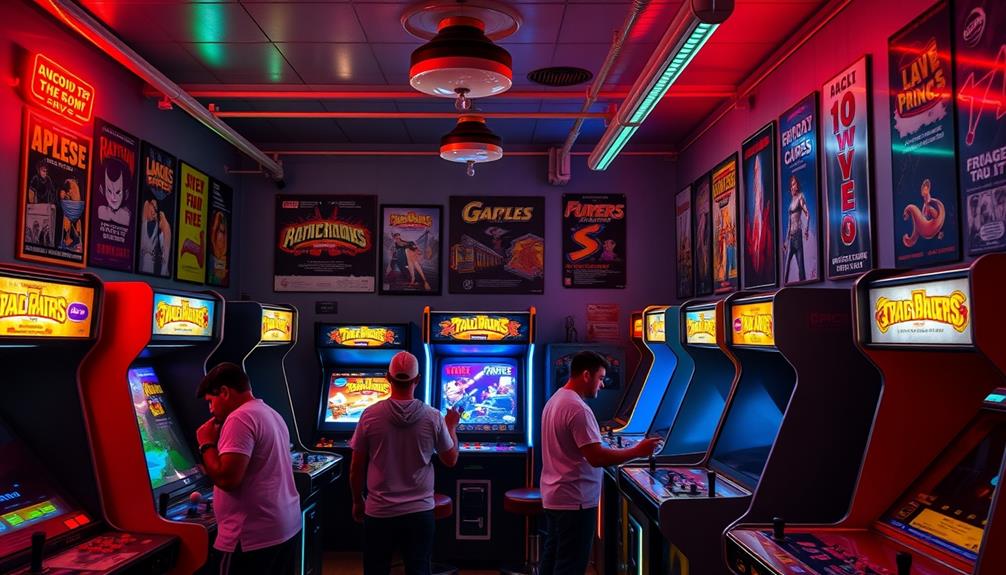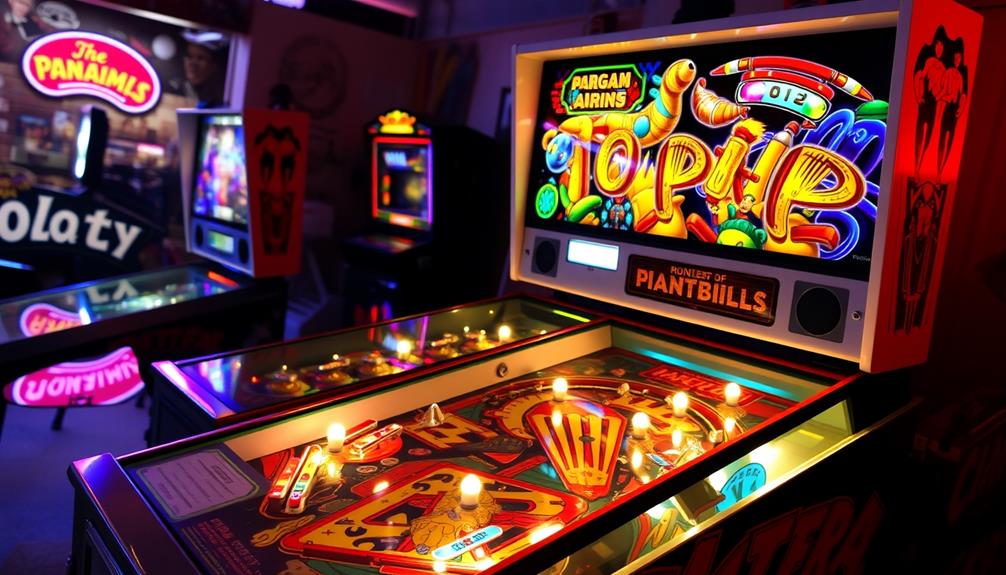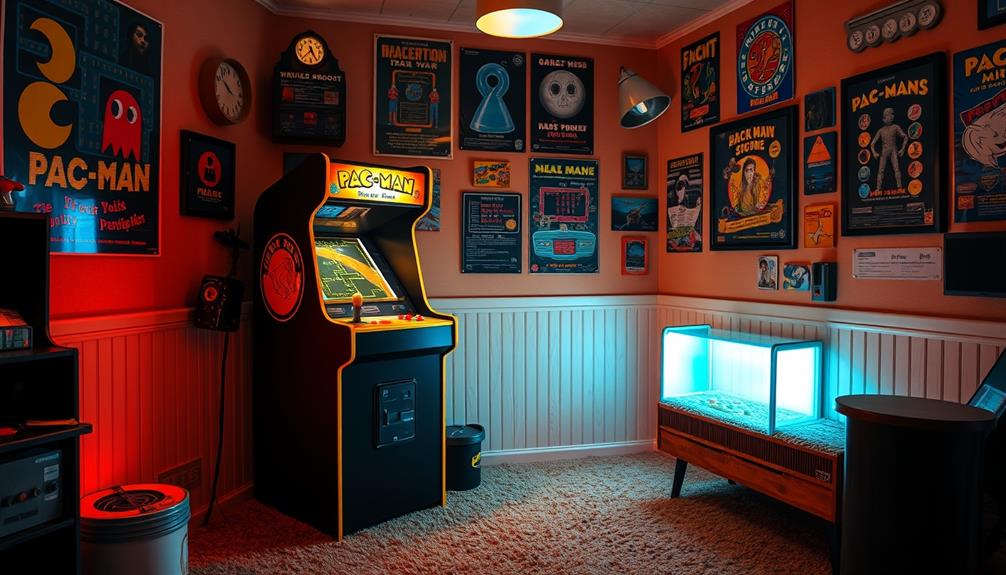A pinball machine is not just a game, but a vibrant piece of art and engineering. The colorful cabinet that encases the playfield, tilted at about 6.5 degrees, is just the beginning. The playfield is filled with interactive elements such as bumpers, ramps, and targets that create a dynamic gameplay experience. The backbox above displays themed artwork and scoring, while the flippers allow you to strategically control the ball. Modern machines even include LCD screens for exciting animations. Each element is carefully designed to draw you in and enhance your experience, leaving you eager to discover more fascinating details about these enchanting machines. Taking a step back to explore the history of em pinball machines will amaze you with the evolution of this beloved game. From their humble beginnings in the 1930s to their peak in popularity during the arcade boom of the 1970s and 80s, these machines have always been a source of entertainment and joy for players of all ages. The technological advancements and creative innovations that have shaped the history of em pinball machines make them a truly fascinating subject to explore.
Key Takeaways
- Pinball machines feature a wooden cabinet that houses the playfield and backbox, providing a sturdy structure for gameplay.
- The inclined playfield, typically at 6.5 degrees, is adorned with vibrant artwork and interactive elements like bumpers and ramps.
- The backbox displays scoring information and themed graphics, enhancing the overall aesthetic appeal of the machine.
- Flippers are located at the bottom of the playfield, allowing players to control the ball's movement and strategy.
- Modern pinball machines incorporate LCD screens for animations, adding a contemporary touch to the traditional design.
Overview of Pinball Machines
When you step up to a pinball machine, you're greeted by a striking combination of art and engineering. These machines typically feature a sturdy wooden cabinet that houses the playfield and backbox, along with various electromechanical components. One of the most important pinball machine basics is the playfield, which is typically made of hardboard and covered with a durable screen-printed surface. The backbox houses the scoring and display mechanisms, as well as a glass or acrylic cover to protect them. Understanding these pinball machine basics is key to appreciating the craftsmanship and complexity of these iconic arcade games.
The playfield, inclined at about 6.5 degrees, is an intricate landscape filled with bumpers, spinners, ramps, and targets that enhance your gameplay experience. Each element invites you to engage and score points, making every game unique. The attention to detail in the design is similar to how high refresh rates enhance gaming experiences, ensuring that the thrill of the game is maximized.
Above the cabinet, the backbox serves a dual purpose, displaying your score and showcasing artwork that reflects the game's theme. This visual appeal is integral to the charm of pinball machines, drawing you in even before you start playing. Flippers, located at the bottom of the playfield, are your primary tools for controlling the ball and executing thrilling shots.
Supported by four metal legs, pinball machines offer stability and can be adjusted for the perfect angle. With a front panel that displays striking visuals and includes sound and lighting effects, every aspect of a pinball machine is designed to immerse you in an enchanting gaming experience.
Historical Development of Pinball

Pinball has a rich history that spans centuries, evolving from simple games to the intricate machines we're familiar with today. The origins trace back to the French game bagatelle, introduced in 1777, where players rolled balls toward pins and scoring holes.
American soldiers during the Revolutionary War embraced the game, coining the term "pinball" as they shifted from skittles to playing with pins on tables. This evolution reflects a broader theme of curiosity and creativity, as inventors continuously sought to enhance gameplay and user experience.
By the 1930s, the first coin-operated pinball machines appeared, with Gottlieb's Baffle Ball becoming hugely popular. It sold for $17.50, allowing players to dispense several balls for just a penny.
The introduction of flippers in 1947 with Gottlieb's Humpty Dumpty revolutionized gameplay, altering it from chance to skill-based interaction, which made pinball games even more engaging.
As the late 20th century rolled in, classic pinball machines filled bars and arcades, but their popularity waned with the rise of video games.
Today, you can find new pinball machines that pay homage to the past while incorporating cutting-edge technology, keeping the spirit of pinball alive in modern machines.
Key Components of Pinball Machines

A typical pinball machine consists of several key components that work together to create an engaging gaming experience. At the foundation, the cabinet serves as the frame, housing the playfield, backbox, and all electronic components, traditionally made of wood for durability.
The playfield is where you'll spend most of your time, filled with various targets, ramps, and interactive features designed to challenge and entertain you. Understanding the mechanics of these elements can enhance your gameplay experience, much like how various brewing methods affect the richness of coffee flavor.
Above the playfield, the backbox displays essential scoring information and themed artwork, often enhanced by stylized graphics on the backglass that immerse you in the game's narrative.
Your control over the game comes primarily through the flippers—these significant components allow you to redirect the ball and strategize your moves during play.
You'll also encounter bumpers, which are mushroom-shaped elements that bounce the ball upon contact, adding excitement and unpredictability to the game.
Finally, the plunger launches the ball into action, while the sturdy legs elevate the machine, ensuring it's comfortable for you to play.
Together, these components create the dynamic world of pinball that keeps you coming back for more.
Playfield Features and Elements

When you look at a pinball machine's playfield, you'll notice a variety of interactive accessories that make the game exciting.
High-quality content on pinball features can boost your understanding and appreciation of the game. From bumpers that bounce your ball to ramps that guide it along tricky paths, each feature adds a unique twist to your gameplay experience.
Understanding how these elements contribute to scoring can really enhance your strategy, especially when considering the importance of content relevance and authority in enhancing your overall gaming knowledge.
Interactive Accessories Overview
Throughout the vibrant playfield of a pinball machine, you'll discover an array of interactive accessories that elevate both gameplay and excitement. These elements, including bumpers, spinners, ramps, and targets, create a dynamic experience for players like you, much like the benefits of choosing the best heat pump.
Bumpers, usually shaped like mushrooms, bounce the ball upon contact, adding a thrilling unpredictability to your shots. They're often arranged in triangular formations, which enhances interactions and keeps you on your toes.
Spinners, on the other hand, are rotating plates that trigger additional game effects when the ball rolls through them, ramping up the excitement with each spin.
Ramps play an essential role in guiding the ball across the playfield, often made from metal or plastic. They provide unique pathways and scoring opportunities, allowing you to strategically plan your shots.
Finally, targets—whether standup or drop types—react upon impact, presenting specific challenges tied to the machine's theme. Hitting these targets often feels rewarding, as they contribute to your overall gameplay experience.
Together, these interactive accessories make every game of pinball a unique adventure, ensuring that you'll always find new ways to engage and enjoy.
Scoring Mechanisms Explained
Understanding scoring mechanisms in a pinball machine is fundamental for maximizing your gameplay. The playfield is filled with interactive elements designed to keep you engaged and boost your score. Bumpers, often mushroom-shaped, are strategically placed, creating dynamic scoring opportunities as they propel the ball upon contact. You'll want to aim for these bumpers to rack up points quickly. The thrill of hitting these bumpers can evoke feelings of joy and nostalgia, much like the uplifting essence of a song such as Blue Skies and Lemonade.
Flippers play a significant role in redirecting the ball, keeping it in play, and targeting specific areas to score. Mastering the timing and angle of your flipper shots can lead to impressive scoring.
Ramps are another exciting feature; when you successfully navigate the ball up a ramp, you can access bonus scoring opportunities or special features that enhance your game.
Additionally, targets—both standup and drop types—react to ball impact, further contributing to your scoring. Hitting these targets can grant additional gameplay features or bonuses, making it important to focus on them during your play.
Visual and Aesthetic Design

When you look at a pinball machine, the vibrant playfield artwork grabs your attention right away, filled with intricate designs that enhance the theme.
Much like the enchanting settings of recent weddings, such as Billy Gilmans Secret Wedding, the visuals on a pinball machine create an immersive experience.
The cabinet and backbox are equally striking, showcasing eye-catching graphics and housing essential scoring displays.
Together, these elements create a visual experience that draws you into the game.
Playfield Artwork and Features
The playfield of a pinball machine is a vibrant canvas that captivates players with its intricate artwork and dynamic features. As you gaze upon it, you'll notice how the rich, detailed artwork reflects the machine's theme, bursting with vibrant colors and graphics. This visual appeal is further enhanced by interactive components, bringing the playfield to life.
Many modern pinball machines draw inspiration from popular culture, incorporating themes that resonate with players, similar to how top hotels with water parks attract families with engaging features.
- The playfield is typically inclined at about 6.5 degrees, allowing for thrilling ball movement.
- Bumpers, ramps, and spinners are strategically placed, creating engaging gameplay experiences.
- Various targets—both standup and drop—react when hit, adding to the aesthetic complexity.
- Many machines now feature LCD screens integrated into the playfield, displaying animations and scores.
- The combination of artwork and features guides your attention, making each game unique.
These elements work together to create an immersive experience, drawing you into the game's narrative while keeping you engaged.
As you play, the interplay of bumpers and targets not only challenges you but also enriches the visual spectacle, ensuring that your time at the machine is both entertaining and memorable.
Cabinet and Backbox Design
Have you ever noticed how the cabinet and backbox of a pinball machine play an essential role in its overall aesthetic? The cabinet, shaped like a box, serves as the sturdy frame of the machine. It's typically made of wood and features vibrant graphics that reflect the game's theme, instantly grabbing your attention.
The use of specific colors and designs can evoke certain emotions, much like music therapy enhances emotional well-being. The backbox sits atop the cabinet, housing essential scoring displays and eye-catching artwork. It often includes stylized graphics on the backglass, acting as a visual advertisement for the game.
As you look closer, you'll see that the playfield artwork is rich in detail, showcasing various targets and interactive elements that enhance gameplay. The graphics on both the cabinet and backbox contribute to the immersive experience, aligning perfectly with the machine's theme.
Plus, the inclination of the playfield, usually set at about 6.5 degrees, affects how the ball moves, adding another layer to the visual experience.
Modern machines have taken this design to the next level, incorporating LCD screens for animations and additional visual effects, further enhancing the aesthetic appeal of both the cabinet and backbox.
Gameplay Mechanics and Objectives

Pinball gameplay revolves around the thrilling pursuit of high scores, where you aim to outshine others on the leaderboard by entering your initials after a game. To achieve this, you need to master various mechanics and complete unique challenges that each machine offers.
The introduction of flippers at the bottom of the playfield lets you control the ball's direction, adding a skillful element to your gameplay experience. Additionally, just like in essential oils for dizziness relief, where the right blend can enhance your experience, understanding the nuances of pinball can elevate your enjoyment and performance.
Key components enhance your strategy and excitement:
- Pop bumpers: Hit these for quick points and to keep the ball in play.
- Ramps: Navigate these to elevate your score and trigger special features.
- Loops: Experience unpredictable ball paths that can lead to surprising outcomes.
- Targets: Knock these down to complete missions and earn valuable bonuses.
- Light effects: Follow these cues to maximize your scoring potential and celebrate achievements.
Evolution of Technology in Pinball

Revolutionizing the pinball experience, technology has played a crucial role in transforming how players interact with machines. The introduction of microprocessors in the late 1970s marked a significant shift, replacing electromechanical relays and enabling more complex gameplay mechanics.
You can trace the evolution back to Gottlieb's Humpty Dumpty in 1947, which was the first machine to feature player-controlled flippers, paving the way for skill-based play.
As the years passed, the change from mechanical reels to digital displays enhanced visual feedback and player engagement. Today, modern pinball machines often incorporate LCD screens for video animations and game updates, making the experience more immersive, almost like a video game.
These advancements not only improve gameplay but also keep you informed about your progress and strategies.
In the early 2020s, the development of contactless payment terminals further revolutionized how you access and enjoy these machines. No more fumbling for coins; now, you can seamlessly jump into the action.
With each technological leap, the world of pinball continues to evolve, ensuring that your gaming experience remains fresh and exciting.
Cultural Significance and Trends

Celebrating the cultural significance of pinball machines reveals their enduring appeal in both public spaces and private homes. Since the 2000s, you've likely noticed a resurgence in pinball, as more people invest in new and refurbished models. This interest has led to price increases and a stronger community surrounding pinball culture.
Enthusiasts share their experiences and favorite machines, creating a vibrant atmosphere that's hard to ignore.
Here are a few trends shaping the pinball landscape:
- Increased demand for home consoles that accommodate pinball machines
- The rise of virtual pinball (vpins) blending digital and physical play
- A growing pinball division that fosters community engagement
- Online modes for leaderboards and game updates
- A focus on preserving traditional machines while innovating gameplay
These elements highlight how pinball adapts to modern gaming preferences while maintaining its cultural significance.
As you explore this enthralling world, you'll find that pinball isn't just a game; it's a cherished tradition that continues to evolve, inviting new generations to experience the joy of flippers and flashing lights.
Frequently Asked Questions
Why Was Pinball Illegal?
Pinball was illegal due to fears it promoted gambling and crime. Authorities believed it corrupted youth, leading to bans in cities like New York. It wasn't until the 1970s that perceptions shifted toward recognizing it as a skill game.
How Much Is a Pinball Machine Worth?
A pinball machine's worth varies widely. New models cost between $6,999 and $9,999, while used ones can be much cheaper. Refurbished machines range from $3,000 to $7,000, and antiques can fetch thousands, depending on rarity.
Do Pinball Machines Still Exist?
Yes, pinball machines still exist and have gained popularity in homes since the 2000s. You'll find new releases annually, featuring innovative designs and themes, making them a fun addition to your entertainment options.
Do Pinballs Roll or Slide?
Pinballs primarily roll, not slide. Their spherical shape and the sloped playfield create a seamless, smooth trajectory. You'll enjoy watching them race around, bouncing off bumpers and spinning through ramps, enhancing your gaming experience.
Conclusion
In the vibrant world of pinball machines, each game invites you to a thrilling dance of lights, sounds, and skill. You've journeyed from their humble beginnings to the dazzling displays of modern designs, where every flick of a flipper ignites excitement. As you step up to the playfield, remember that you're not just playing—you're part of a rich tapestry woven with history and culture, echoing laughter and competition with every bounce of the silver ball.
